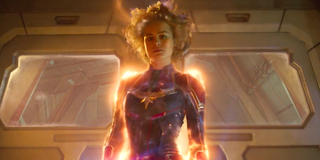Marvel’s Approach To Sequels Is Evolving, And Kevin Feige Says Captain Marvel Is A Great Example Of Why

When a superhero property has a sequel, it usually only has to worry about the characters who were introduced in the immediate predecessor. Each X-Men sequel kept its focus on the core team, and the Batman sequels continued the adventures of whomever was in the suit at the time, from Michael Keaton to Christian Bale. The Marvel Cinematic Universe is a different situation. Now that the studio has made it to Phase Four, it has so many characters at its disposal, and the ability to weave stories from films to Disney+ series, and back again. This has impacted the way that the creators at Marvel Studios will be approaching stories from here on out, according to the company’s president, Kevin Feige.
Feige sat down with CinemaBlend in preparation for the release of next week’s Shang-Chi and the Legend of the Ten Rings, but also talked about the big picture plans of the MCU moving forward. In discussing the way that the shows can now affect the movies -- sort of how Wanda Maximoff (Elizabeth Olsen) will transition to Doctor Strange in the Multiverse of Madness after delivering an awards-worthy performance in WandaVision -- I asked him if that mean the definition of a traditional “sequel” was evolving at Marvel Studios. His answer can be found in the video above.
Wanda is only one example of a character who is fluidly moving back and forth between the big and small screens for the MCU. In the end-credits sequence of Black Widow, fans basically learned that Yelena Belova (Florence Pugh) would next appear in the Hawkeye series that Jeremy Renner will hold down. That scene also had Valentina Allegra de Fontaine (Julia Louis-Dreyfus), a pivotal character we first met in The Falcon and the Winter Soldier. So these transitions are becoming more common, finding new ways to expand the world.
Opening up about how the MCU will adapt to this new reality, Kevin Feige told CinemaBlend:
I think it’s always the way we’ve tried to approach (sequels), which is, ‘What is the next story and how can we continue to evolve a film series?’ I think my favorite example goes back to Captain America: The First Avenger, a World War II movie, and then Captain America: The Winter Soldier, a political espionage thriller. When the audience responded to that, it really fulfilled our hopes that we'd be able to continue to take these characters and grow and evolve the genres in which they're in.
But as Feige continued to trace the path of some of the upcoming MCU movies reaching theaters in 2022, he talked about how the films and shows will continue to intertwine. He told us:
And you're absolutely right. Captain Marvel (was) a Nineties buddy action origin story, in some ways, with Carol and Nick. And that spun both into her appearance in Endgame, but also spins into The Marvels and into Secret Invasion, with the Ben Mendelsohn character, Talos. So, it is great fun. And again, following the example from the comics of being able to take these characters, audiences say, ‘I respond to this character. I like these characters.’ And then it is our job to not keep delivering more of the same, but to take those characters they like and put them into different environments and deeper stories.
There are two more Marvel movies opening in 2021 after Shang-Chi: Eternals in November and Spider-Man: No Way Home in December. But the Disney+ slate is packed, with shows like Ms. Marvel leading into Moon Knight, She-Hulk and more. Keep up to date with upcoming Marvel movies here, and upcoming Marvel TV shows here.
CINEMABLEND NEWSLETTER
Your Daily Blend of Entertainment News

Sean O’Connell is a journalist and CinemaBlend’s Managing Editor. Having been with the site since 2011, Sean interviewed myriad directors, actors and producers, and created ReelBlend, which he proudly cohosts with Jake Hamilton and Kevin McCarthy. And he's the author of RELEASE THE SNYDER CUT, the Spider-Man history book WITH GREAT POWER, and an upcoming book about Bruce Willis.
Most Popular




